SEO for photographers: 9 tips to improve your rankings
Search engine optimization (SEO) is the process of optimizing a website to enhance its visibility and ranking on search engine results pages (SERPs).
Like any other business, photographers can significantly benefit from SEO, which helps showcase their work to a broader audience and attract potential clients.
In this article, we’ll explore nine essential tips for improving your SEO rankings and ensuring your photography website gains the recognition it deserves.
What is SEO for photographers
SEO for photographers refers to the strategies and techniques used to improve your photography website’s visibility on search engines like Google.
For example, when people search for “photography services” or “wedding photographer” on Google, you want your photography website to appear on the first page of the results. This increases your chances of getting new clients and growing your business.
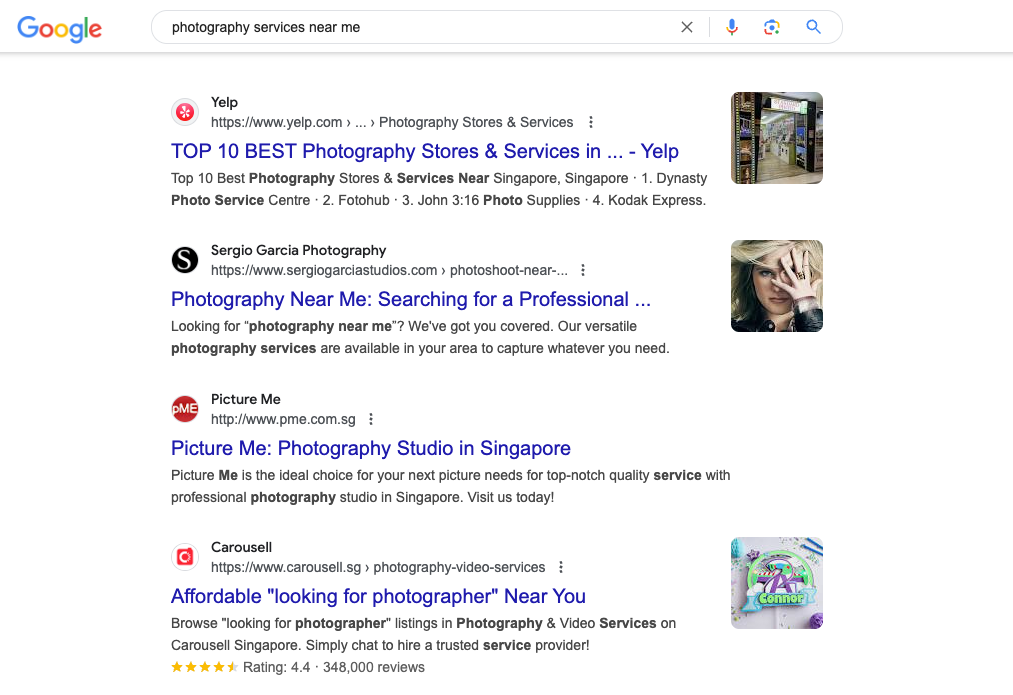
Although SEO isn’t a one-time solution, you shouldn’t be intimidated. With the right approach and consistent effort, you can significantly improve your website’s SEO and boost your online presence.
9 SEO tips for photographers
Each tip is presented in a step-by-step approach, making it simple to implement as you go.
1. Identify photography keywords
One of the fundamental SEO strategies is using the right keywords. These keywords act as search terms people use when looking for specific content online.
As a photographer, you should identify keywords related to your niche and use them in your website’s titles, descriptions, and content. Some examples include “wedding photography,” “portrait photography,” “landscape photography,” and so on.
We recommend using Google Keyword Planner to identify your keywords. If you’re unsure what keywords to add, Google can list your keyword choices based on your website.
Under Discover new keywords, choose Start with a website and add URL.

On the same URL field, you can research competitors’ keywords by entering their URLs instead of yours. This will give you further insights into what keywords they’re using that you may not have thought of.
After listing your keywords, check how often they are searched each month. The higher the volume, the more popular and competitive the keyword is, which is something you should avoid. In addition, pay attention to the competition level of each keyword.
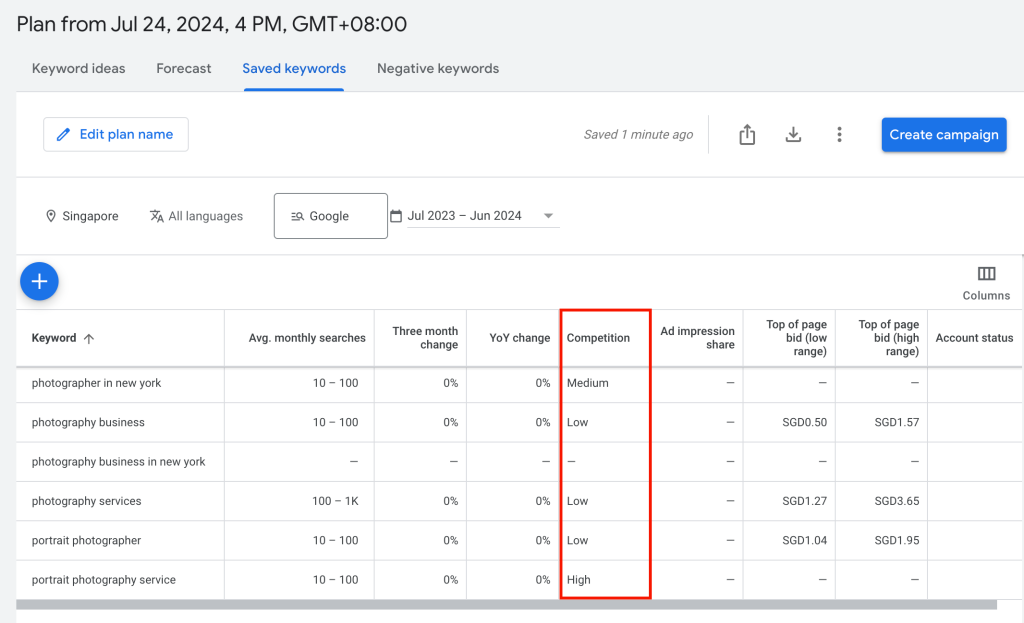
Find a good balance between keywords with a high search volume and low-to-medium competition. This will help improve your search engine ranking.
Make sure to use long-tail keywords, which have less competition. Long-tail keywords are longer phrases that are more specific and targeted. For example, instead of using “wedding photography” as a keyword, try using “destination wedding photographer in New York.”
After identifying the right keywords, you can use them for different elements of your website and overall online presence. This includes page title, meta description, image alt text, and web page content, which we’ll cover more in the following steps.
2. Optimize titles and descriptions
SEO titles and descriptions are the text under your website name in Google search results. The title acts as the clickable headline, and the description briefly previews the web page’s content.

SEO titles and descriptions can help improve your website’s visibility and click-through rate (CTR) from search results. CTR is the percentage of people who clicked on your website in search results compared to the total number of people who saw it.
Here are some best practices for creating effective titles and descriptions:
- Keyword placement. Include relevant keywords at the beginning of the title and description to signal to both search engines and readers what the page is about.
- Character limits. Keep titles under 60 characters and descriptions around 155 characters. Use tools like ToTheWeb to help check the length of your meta title and description.

- Overusing keywords. Keyword stuffing, which involves repeating the exact keywords, can make the text sound unnatural and may lead to penalties from search engines. Aim for a natural flow in your writing.
- Include calls to action. Along with action words, include a clear call to action in your description, such as “Sign up for our newsletter” or “Shop now.”
Most of the time, your meta title and description are automatically generated based on the content of your page. However, you can customize them for better SEO practice.
With Hostinger Website Builder, you can easily update your SEO titles and descriptions. On the site editor page, go to Website settings → SEO settings page. Scroll down until you see the title and description fields to start customizing.

Hostinger also previews how your titles and descriptions will look in search results, allowing you to tweak them to your liking before publishing.

3. Improve your URLs
An SEO-friendly URL structure is crucial for search engines and overall user experience.
For search engines, a clear and organized URL helps them understand the content on your page. For example, a concise and readable URL makes it easier to navigate your site and remember the link.
When creating URLs for your pages, make sure they’re relevant to the content and include target keywords. Use hyphens to separate words in the URL, as search engines recognize them as word separators.
Further, avoid using numbers or symbols in your URLs, as they can mislead search engines and users.
Here’s an example of a non-optimized URL:
www.capturemoments.com/blog/article159
This URL uses an ambiguous identifier, such as “article159,” which offers no insight into the content for users or search engines.
Now, here’s an example of an SEO-friendly URL:
www.capturemoments.com/blog/landscape-photography-tips
You can edit your URLs using Hostinger Website Builder. To do so, go to Website settings → SEO settings. Scroll down until you see the Page URL field.

4. Make your photography website mobile-friendly
Having a mobile-friendly website ensures that your images will adapt to fit any screen size. This allows for a better viewing experience on all devices and makes your photography website more visually appealing.
Start by checking your website’s speed to ensure it’s mobile-friendly. Mobile-responsive websites typically load in under three seconds, which helps retain users’ attention.
You can use Google PageSpeed Insights to test your website’s speed and identify areas for improvement.

Next, make sure your images are optimized for mobile viewing. This means compressing large files to reduce loading times and using the right file type, which can impact image quality.
An alternative way to optimize your photography website for mobile devices is to use a responsive design. Responsive design ensures your images will automatically resize and reposition to fit the current screen, providing a seamless and hassle-free user experience.
Fortunately, most website platforms, including Hostinger Website Builder, offer responsive design out of the gate. This means you don’t need to do additional design work to make your website mobile-friendly.
So remember, whether you choose to build your website using AI or a pre-made template, ensure your photography site is optimized for mobile devices. This will boost your Google rankings immensely.
5. Add image alt text
As a part of image SEO, alternative text, also known as alt text, describes the content of an image on a webpage. Adding alt text to your website images helps with SEO and web accessibility.
From an SEO standpoint, adding alt text enhances your images’ ranking in search engine results. It provides search engines context about the image’s relevance to the surrounding content.
For accessibility, alt text ensures that all users, regardless of visual capabilities, have a complete and inclusive experience when visiting your website.
Keep these tips in mind when writing your image alt text:
- Be descriptive. Clearly describe what is shown in the image, focusing on details highlighting its content and context.
- Use keywords wisely. Include relevant keywords that relate to the content of the article or page, but avoid stuffing keywords unnecessarily, as search engines can penalize this.
- Keep it concise. Aim for no more than 125 characters, and ensure the description is clear and concise.
To add image alt text, simply edit the image within your website. For this example, we’ll show how to do this using Hostinger Website Builder:
- Click on any image and select Edit image.
- You should find the alt text box under the Image settings.
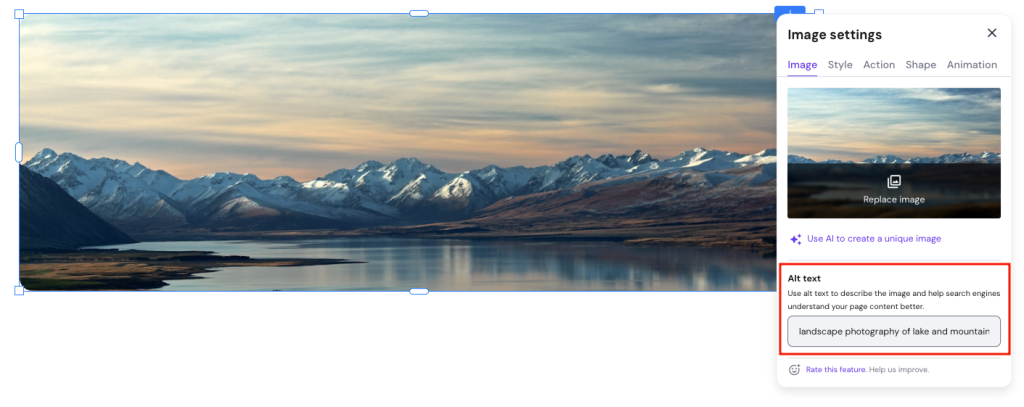
6. Create high-quality content that helps readers
SEO-friendly content, such as blogs and informative pages, is a great way to create high-quality content that helps readers and improves SEO.
When writing a blog post, consider the Google E-E-A-T framework for added SEO value and aligning your content with user search intent. E-E-A-T stands for Experience, Expertise, Authoritativeness, and Trustworthiness.
Google uses E-E-A-T as a benchmark to assess the quality of content. High E-E-A-T scores mean the content is likely useful, accurate, and valuable to readers, making it more favorable in search engine rankings.
When writing engaging, optimized content based on E-E-A-T principles, start by showcasing your experience. For example, if you’re writing about photography techniques, describe specific challenges and how you overcame them.
Second, demonstrate your expertise by using well-researched data and include insights from credible sources. Always provide thorough explanations that reflect a deep understanding of the subject.
Third, establish authority by linking to reputable sites, citing recognized experts in your field, and contributing to discussions on authoritative forums or publications. We’ll cover more about this in the next part.
Finally, ensure trustworthiness and be transparent about your qualifications and the sources of your information. Avoid making unsupported claims and always strive to provide accurate and updated information.
To help you write blog posts, use Hostinger Website Builder’s AI Writer. Start by adding a blog page by going to Pages and navigation → Blog. Then, edit one of the blog post placeholders and click AI Writer.

Create a short description of the blog post topic to generate relevant content, and click Create text. The AI Writer tool will analyze your input and provide suggested content for you to work with.
7. Build high-quality backlinks
Backlinks, also known as inbound links or incoming links, are links that lead from one website to a page on another site. The more high-quality backlinks your website has, the more reputable it appears to search engines.
High-quality backlinks come from relevant and authoritative websites in your industry. These links are more valuable because search engines see them as more credible. Conversely, backlinks from low-quality or irrelevant sites can harm your SEO efforts.
You can use Ahrefs’ Website Authority Checker to check whether a website has enough authority for a quality backlink. Aim for backlinks from websites with a score of at least 50 points.
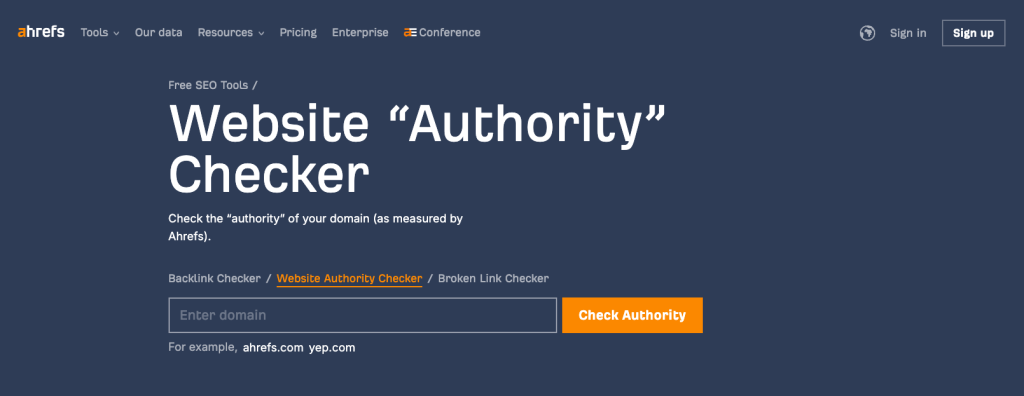
Consider reaching out to industry influencers or creating valuable content that other websites will want to link to in order to increase the number of quality backlinks pointing to your site.
Here are several effective strategies to help you earn valuable backlinks:
- Guest blogging. Write articles for reputable blogs or websites in your industry and include a link to your website, which will drive traffic and improve your site’s authority.
- Collaborations. Partner with other photographers or related businesses for projects, webinars, or photo shoots. These collaborations often result in natural backlink opportunities as partners may link to your website in their content.
- Creating shareable content. Produce high-quality, informative, and engaging content others want to link to. This could be unique research, comprehensive guides, or compelling visual content like infographics.
Building high-quality backlinks takes time and effort, but it’s essential for improving your SEO ranking and driving more organic traffic to your site.
8. List your business on Google Business Profile
A Google Business Profile benefits you because it’s a part of local SEO. Local SEO is the process of optimizing a website or online presence to appear in local search results when people are searching for businesses or services in their specific location.
For a photography business with a physical location, a Google Business Profile is crucial. It allows potential customers to easily find your business and learn important information such as location, hours of operation, reviews, and contact information.
Go to the Google Business Profile page to start listing your business. Click Manage now to get started.
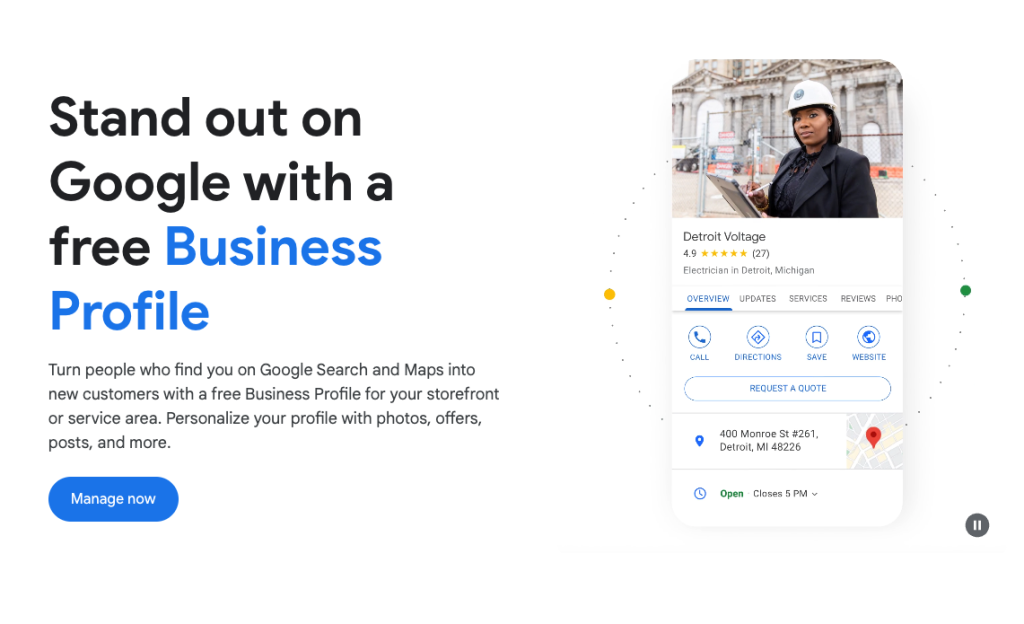
Include your business name and choose your business type. Select all options that apply to your photography business.
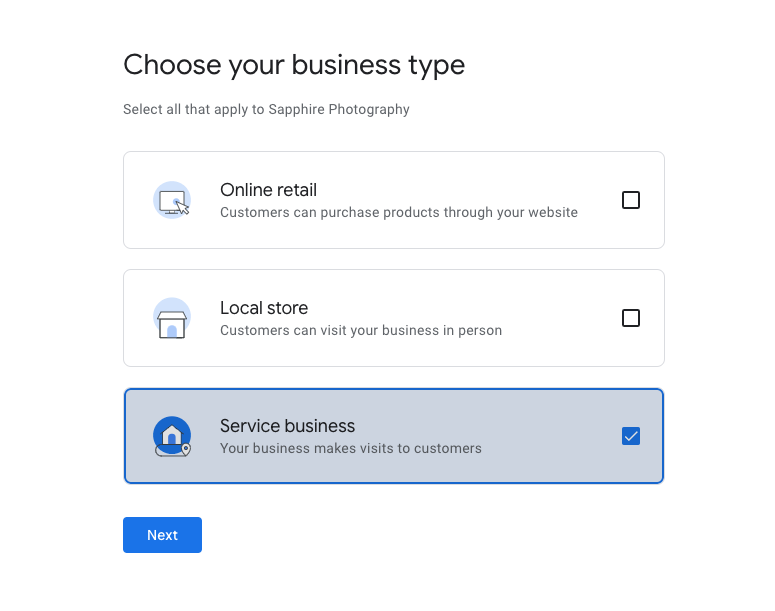
Then, fill out the business category name and add your business location or areas that cover your photography services. In addition, add an up-to-date name, address, and phone number to help potential clients find and contact you easily.
Having a Google Business profile also helps Google Maps reviews appear prominently in search results, making it easier for potential clients to see positive reviews from previous customers.
9. Track your SEO performance
Tracking SEO performance can help you understand how well your website is doing in search engines. You can also see what’s working and what isn’t, then adjust your strategies to increase your website’s visibility, traffic, and conversions.
Start by signing up for a Google Analytics account. After setting up your account, Google Analytics will provide a tag. This Google tag needs to be added to every page on your website.
You can do this manually in your website’s HTML or through a CMS or website builder that supports Google Analytics integration.
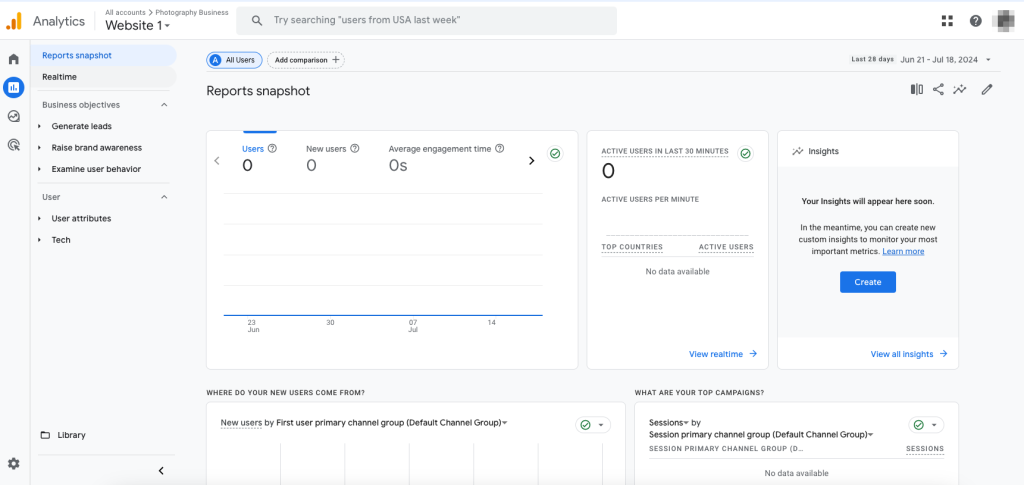
Once set up, here are the key performance metrics to monitor:
- Bounce rate. Measures the percentage of visitors who leave your site after viewing only a single page. A high bounce rate might indicate your pages need to be more relevant or engaging.
- Session duration. Tracks the average amount of time users spend on your site. Longer sessions indicate more engaging content or effective site navigation.
- Conversion rate. The percentage of visitors who complete a desired action, like filling out a contact form or purchasing. This metric evaluates your site’s effectiveness in converting visitors into customers or leads.
- Organic search traffic. Tracks visitors who come to your site from search engine results. Increasing organic traffic is often the primary goal of SEO.
- Mobile traffic. Estimates how many visitors access your site via mobile devices.
- Page load time. Measures how quickly your pages load for visitors. Page speed is crucial for excellent user experience and can impact search engine rankings.
Check these metrics regularly to monitor your website’s success and make any necessary adjustments.
Conclusion
SEO for photographers is more than just improving visibility. It strategically enhances your digital presence so your work gets the attention it deserves on search engines.
This article has guided you through essential photography SEO strategies. Implementing them will increase your website’s traffic, improve user experience, and ultimately attract more clients.
Remember to regularly monitor your metrics and adapt your strategies to stay ahead of the competition.
Lastly, remember that making your website SEO-friendly is an ongoing process that requires regular maintenance and updates. Keep up with the latest trends and algorithms to ensure your photography website remains relevant and competitive.
SEO for photographers FAQ
How important is image optimization for SEO in photography?
To put it briefly, it’s almost necessary. Optimizing your images makes them load faster and appear better in search results. This is essential for showcasing your photography work and enhancing the overall user experience.
Where can I learn about SEO for photographers?
You can dive into specialized photography blogs, enroll in online courses on Udemy or Coursera, and explore digital marketing websites focusing on SEO. These resources are packed with targeted SEO strategies, including for photographers.
Is it necessary for photographers to have a blog for better SEO?
Blogging is essential for regularly updating your website with new content, focusing on particular keywords, and interacting more effectively with your audience. These activities are crucial for achieving higher search engine rankings and building a stronger online presence.




